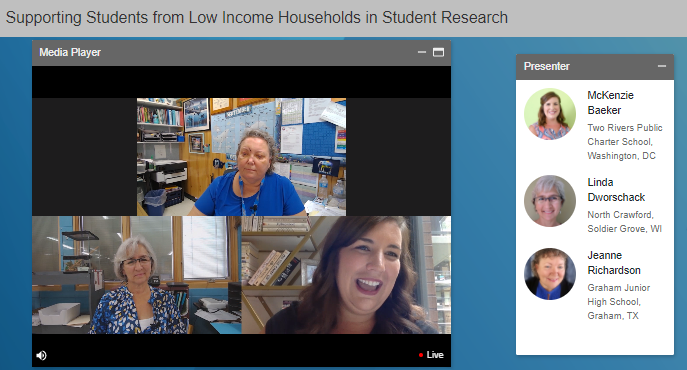Middle School science teachers discuss supporting low income households

During the Society’s second Middle School Research Teachers Conference last month, 163 teachers from 25 states; Washington, D.C.; Puerto Rico and American Samoa virtually convened to share their expertise with one another and learn best practices. One of the online sessions featured a discussion about how to support students from low income households in science research. Three educators—Jeanne Richardson from Graham Junior High in Texas, Linda Dworshack from North Crawford School in Wisconsin and McKenzie Baecker from Two Rivers Public Charter School in Washington D.C.—answered a number of questions that are relevant to this critical topic. We share an edited excerpt of their valuable insights below.
How do you build relationships with the families of students doing research so that they all feel supported and empowered?
McKenzie: “First and foremost when thinking about this question is that we need to assume families do want to be involved.” With students from low income households, it’s easy to assume that the family doesn’t want to be involved, which then automatically puts up a barrier to then be able to engage with the family.
How I go about building these relationships is really just being personable with them ─ calling, texting, emailing and meeting them in the format that works best for them. Before COVID-19, if they wanted to meet at a coffee shop, that’s what I would do. If it’s easier for parents to text because they’re at work and can’t take phone calls, that’s how we communicate. It truly is important that we are meeting them where they are, but also ensuring that we’re listening to their questions and feedback at any given point. Then, we make sure that they can see how we are changing our curriculum and our approach based on their questions and feedback. It is a lifelong relationship that you not only get to keep with students, but also with their families.”
Jeanne: “Sometimes that’s very difficult because of the language barrier. We have a large Hispanic population, but my Spanish isn’t great, so sometimes that requires getting a friend to help translate. The best person to help translate is usually the student. We have open houses and that’s my biggest opportunity to meet these parents and I get one shot. I meet them and tell them about our year, our science fair and how their kids may be involved. Once you’ve planted that seed, the parents then start checking in with the students about these activities. It’s getting involved with the families and then following up on those relationships as the year goes on.”
How do you build relationships with school administrators and teachers in your schools and beyond, in order to host science fairs and encourage participation?
Linda: “This makes me think of the importance of keeping really good records about the successes that our students are having. When you go to the school board or to the administration, having those facts and figures to share can be really important. Even though the administration can respond to my passion for science, sometimes the school board doesn’t respond as favorably. So, it needs to be backed up with numbers.
I have my strengths as a teacher. My coworkers also have strengths and can reach students in ways that I can’t. So, I’ve worked with them and they’ve been willing to help out during the science fair program. The math teacher will help with some data analysis, making spreadsheets and graphs. These are things I could certainly do in the science classroom, but for them to see that science extends into other fields is really important.”
What steps can science fairs take to make them more accessible to students from low income households?
McKenzie: “One of the most important things is identifying the barriers for student access to science fairs and researching on their own. Obviously, funding is a large barrier that all of us face. Really being creative about what resources do we need and asking ‘do we need a ton of fancy equipment to do quality science research?’ No, we don’t. There are tools that students, including low income students, have around their households that they can use to complete science research.
It’s also important to make sure the research is aligned with the student’s personal interests. My students develop their research questions or their engineering problem statements by answering ‘what is the question that you want answered in your own life?’ or ‘what is the problem that you need to solve in your own life?’ By personalizing the research topics I have found that the resources tend to be at their disposal already because they’re using things that they see on daily basis. They’re using the network of people who they see all of the time.”
How do you build and foster a culture at your school that is enthusiastic about science and research?
Jeanne: “As a teacher you have got to be enthusiastic about science. It is contagious. If you are excited about it, the kids will be too, and before you know it, so will the parents.”
McKenzie: “If you have a passion for it and you love your kids, the sky is the limit. You have everything you need at your disposal with those two things.”


